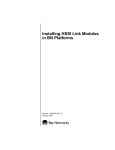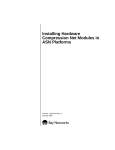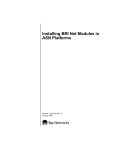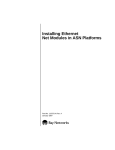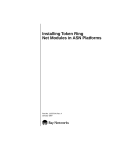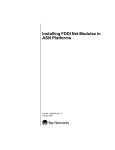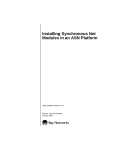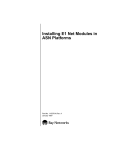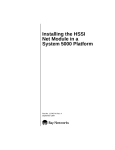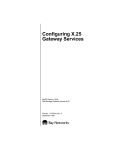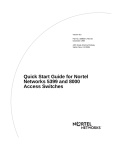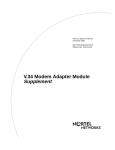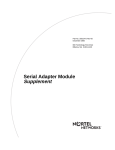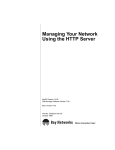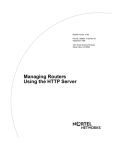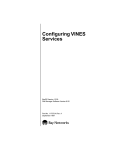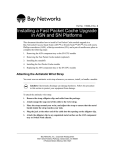Download Avaya HSSI Net Module in an ASN Platform User's Manual
Transcript
Installing the HSSI Net Module in an ASN Platform Part No. 117406-A Rev. A September 1997 4401 Great America Parkway Santa Clara, CA 95054 8 Federal Street Billerica, MA 01821 Copyright © 1997 Bay Networks, Inc. All rights reserved. Printed in the USA. September 1997. The information in this document is subject to change without notice. The statements, configurations, technical data, and recommendations in this document are believed to be accurate and reliable, but are presented without express or implied warranty. Users must take full responsibility for their applications of any products specified in this document. The information in this document is proprietary to Bay Networks, Inc. Trademarks Bay Networks is a registered trademark, and ASN, Bay Networks Press, and the Bay Networks logo are trademarks of Bay Networks, Inc. All other trademarks and registered trademarks are the property of their respective owners. Statement of Conditions In the interest of improving internal design, operational function, and/or reliability, Bay Networks, Inc. reserves the right to make changes to the products described in this document without notice. Bay Networks, Inc. does not assume any liability that may occur due to the use or application of the product(s) or circuit layout(s) described herein. USA Requirements Only Federal Communications Commission (FCC) Compliance Notice: Radio Frequency Notice Note: This equipment has been tested and found to comply with the limits for a Class A digital device, pursuant to Part 15 of the FCC rules. These limits are designed to provide reasonable protection against harmful interference when the equipment is operated in a commercial environment. This equipment generates, uses, and can radiate radio frequency energy. If it is not installed and used in accordance with the instruction manual, it may cause harmful interference to radio communications. Operation of this equipment in a residential area is likely to cause harmful interference, in which case users will be required to take whatever measures may be necessary to correct the interference at their own expense. Federal Communications Commission (FCC) Compliance Notice: Radio Frequency Notice European Requirements Only EN 55 022 Statement This is to certify that the Bay Networks HSSI Net Module is shielded against the generation of radio interference in accordance with the application of Council Directive 89/336/EEC, Article 4a. Conformity is declared by the application of EN 55 022 Class A (CISPR 22). Warning: This is a Class A product. In a domestic environment, this product may cause radio interference, in which case, the user may be required to take appropriate measures. EC Declaration of Conformity This product conforms (or these products conform) to the provisions of Council Directive 89/336/EEC and 73/23/EEC. The Declaration of Conformity is available on the Bay Networks World Wide Web site at www.baynetworks.com. ii 117406-A Rev. A Japan/Nippon Requirements Only Voluntary Control Council for Interference (VCCI) Statement Voluntary Control Council for Interference (VCCI) Statement This is a Class A product based on the standard of the Voluntary Control Council for Interference by Information Technology Equipment (VCCI). If this equipment is used in a domestic environment, radio disturbance may arise. When such trouble occurs, the user may be required to take corrective actions. Canada Requirements Only Canadian Department of Communications Radio Interference Regulations This digital apparatus (HSSI Net Module) does not exceed the Class A limits for radio-noise emissions from digital apparatus as set out in the Radio Interference Regulations of the Canadian Department of Communications. Règlement sur le brouillage radioélectrique du ministère des Communications Cet appareil numérique (HSSI Net Module) respecte les limites de bruits radioélectriques visant les appareils numériques de classe A prescrites dans le Règlement sur le brouillage radioélectrique du ministère des Communications du Canada. 117406-A Rev. A iii Canada Requirements Only (continued) Canada CS-03 Rules and Regulations Note: The Canadian Department of Communications label identifies certified equipment. The certification means that the equipment meets certain telecommunications network protective, operational and safety requirements. The Department does not guarantee the equipment will operate to the user’s satisfaction. Before installing this equipment, users should ensure that it is permissible to be connected to the facilities of the local telecommunications company. The equipment must also be installed using an acceptable method of connection. In some cases, the company’s inside wiring associated with a single line individual service may be extended by means of a certified connector assembly (telephone extension cord). The customer should be aware that compliance with the above conditions may not prevent the degradation of service in some situations. Repairs to certified equipment should be made by a representative designated by the supplier. Any repairs or alterations made by the user to this equipment, or equipment malfunctions, may give the telecommunications company cause to request the user to disconnect the equipment. Users should ensure for their own protection that the electrical ground connections of the power utility, telephone lines and internal metallic water pipe system, if present, are connected together. This precaution may be particularly important in rural areas. Caution: Users should not attempt to make such connections themselves, but should contact the appropriate electric inspection authority, or electrician, as appropriate. Notice: For equipment using loopstart lines, please note that the Ringer Equivalence Number (REN) assigned to each terminal device provides an indication of the maximum number of terminals allowed to be connected to a telephone interface. The termination on an interface may consist of any combination of devices subject only to the requirement that the sum of the RENs of all the devices does not exceed 5.0. The REN is located on the “FCC Rules Part 68” label located on the bracket of the module, or on the back of the unit. Canada CS-03 -- Règles et règlements Note: L’étiquette du ministère des Communications du Canada indique que l’appareillage est certifié, c’est-à-dire qu’il respecte certaines exigences de sécurité et de fonctionnement visant les réseaux de télécommunications. Le ministère ne garantit pas que l’appareillage fonctionnera à la satisfaction de l’utilisateur. Avant d’installer l’appareillage, s’assurer qu’il peut être branché aux installations du service de télécommunications local. L’appareillage doit aussi être raccordé selon des méthodes acceptées. Dans certains cas, le câblage interne du service de télécommunications utilisé pour une ligne individuelle peut être allongé au moyen d’un connecteur certifié (prolongateur téléphonique). Le client doit toutefois prendre note qu’une telle installation n’assure pas un service parfait en tout temps. Les réparations de l’appareillage certifié devraient être confiées à un service désigné par le fournisseur. En cas de réparation ou de modification effectuées par l’utilisateur ou de mauvais fonctionnement de l’appareillage, le service de télécommunications peut demander le débranchement de l’appareillage. Pour leur propre sécurité, les utilisateurs devraient s’assurer que les mises à la terre des lignes de distribution d’électricité, des lignes téléphoniques et de la tuyauterie métallique interne sont raccordées ensemble. Cette mesure de sécurité est particulièrement importante en milieu rural. Attention: Les utilisateurs ne doivent pas procéder à ces raccordements eux-mêmes mais doivent plutôt faire appel aux pouvoirs de réglementation en cause ou à un électricien, selon le cas. Avis: Veuillez prendre note que pour tout appareillage supportant des lignes de type “loopstart,” vous pouvez utiliser le Ringer Equivalence Number (REN) attribué à chaque terminal pour déterminer le nombre maximal de terminaux qui peuvent être branchés à votre interface de téléphones. Le raccordement à l’interface pourra se composer de toute combinaison de terminaux, pour autant que la somme des RENs ne dépasse pas cinq. Le REN figure sur l’étiquette “FCC Rules Part 68” située sur le support du module ou à l’arrière de l’unité. iv 117406-A Rev. A Bay Networks, Inc. Software License Agreement NOTICE: Please carefully read this license agreement before copying or using the accompanying software or installing the hardware unit with pre-enabled software (each of which is referred to as “Software” in this Agreement). BY COPYING OR USING THE SOFTWARE, YOU ACCEPT ALL OF THE TERMS AND CONDITIONS OF THIS LICENSE AGREEMENT. THE TERMS EXPRESSED IN THIS AGREEMENT ARE THE ONLY TERMS UNDER WHICH BAY NETWORKS WILL PERMIT YOU TO USE THE SOFTWARE. If you do not accept these terms and conditions, return the product, unused and in the original shipping container, within 30 days of purchase to obtain a credit for the full purchase price 1. License Grant. Bay Networks, Inc. (“Bay Networks”) grants the end user of the Software (“Licensee”) a personal, nonexclusive, nontransferable license: a) to use the Software either on a single computer or, if applicable, on a single authorized device identified by host ID, for which it was originally acquired; b) to copy the Software solely for backup purposes in support of authorized use of the Software; and c) to use and copy the associated user manual solely in support of authorized use of the Software by Licensee. This license applies to the Software only and does not extend to Bay Networks Agent software or other Bay Networks software products. Bay Networks Agent software or other Bay Networks software products are licensed for use under the terms of the applicable Bay Networks, Inc. Software License Agreement that accompanies such software and upon payment by the end user of the applicable license fees for such software. 2. Restrictions on use; reservation of rights. The Software and user manuals are protected under copyright laws. Bay Networks and/or its licensors retain all title and ownership in both the Software and user manuals, including any revisions made by Bay Networks or its licensors. The copyright notice must be reproduced and included with any copy of any portion of the Software or user manuals. Licensee may not modify, translate, decompile, disassemble, use for any competitive analysis, reverse engineer, distribute, or create derivative works from the Software or user manuals or any copy, in whole or in part. Except as expressly provided in this Agreement, Licensee may not copy or transfer the Software or user manuals, in whole or in part. The Software and user manuals embody Bay Networks’ and its licensors’ confidential and proprietary intellectual property. Licensee shall not sublicense, assign, or otherwise disclose to any third party the Software, or any information about the operation, design, performance, or implementation of the Software and user manuals that is confidential to Bay Networks and its licensors; however, Licensee may grant permission to its consultants, subcontractors, and agents to use the Software at Licensee’s facility, provided they have agreed to use the Software only in accordance with the terms of this license. 3. Limited warranty. Bay Networks warrants each item of Software, as delivered by Bay Networks and properly installed and operated on Bay Networks hardware or other equipment it is originally licensed for, to function substantially as described in its accompanying user manual during its warranty period, which begins on the date Software is first shipped to Licensee. If any item of Software fails to so function during its warranty period, as the sole remedy Bay Networks will at its discretion provide a suitable fix, patch, or workaround for the problem that may be included in a future Software release. Bay Networks further warrants to Licensee that the media on which the Software is provided will be free from defects in materials and workmanship under normal use for a period of 90 days from the date Software is first shipped to Licensee. Bay Networks will replace defective media at no charge if it is returned to Bay Networks during the warranty period along with proof of the date of shipment. This warranty does not apply if the media has been damaged as a result of accident, misuse, or abuse. The Licensee assumes all responsibility for selection of the Software to achieve Licensee’s intended results and for the installation, use, and results obtained from the Software. Bay Networks does not warrant a) that the functions contained in the software will meet the Licensee’s requirements, b) that the Software will operate in the hardware or software combinations that the Licensee may select, c) that the operation of the Software will be uninterrupted or error free, or d) that all defects in the operation of the Software will be corrected. Bay Networks is not obligated to remedy any Software defect that cannot be reproduced with the latest Software release. These warranties do not apply to the Software if it has been (i) altered, except by Bay Networks or in accordance with its instructions; (ii) used in conjunction with another vendor’s product, resulting in the defect; or (iii) damaged by improper environment, abuse, misuse, accident, or negligence. THE FOREGOING WARRANTIES AND LIMITATIONS ARE EXCLUSIVE REMEDIES AND ARE IN LIEU OF ALL OTHER WARRANTIES EXPRESS OR IMPLIED, INCLUDING WITHOUT LIMITATION ANY WARRANTY OF MERCHANTABILITY OR FITNESS FOR A PARTICULAR PURPOSE. Licensee is responsible for the security of 117406-A Rev. A v its own data and information and for maintaining adequate procedures apart from the Software to reconstruct lost or altered files, data, or programs. 4. Limitation of liability. IN NO EVENT WILL BAY NETWORKS OR ITS LICENSORS BE LIABLE FOR ANY COST OF SUBSTITUTE PROCUREMENT; SPECIAL, INDIRECT, INCIDENTAL, OR CONSEQUENTIAL DAMAGES; OR ANY DAMAGES RESULTING FROM INACCURATE OR LOST DATA OR LOSS OF USE OR PROFITS ARISING OUT OF OR IN CONNECTION WITH THE PERFORMANCE OF THE SOFTWARE, EVEN IF BAY NETWORKS HAS BEEN ADVISED OF THE POSSIBILITY OF SUCH DAMAGES. IN NO EVENT SHALL THE LIABILITY OF BAY NETWORKS RELATING TO THE SOFTWARE OR THIS AGREEMENT EXCEED THE PRICE PAID TO BAY NETWORKS FOR THE SOFTWARE LICENSE. 5. Government Licensees. This provision applies to all Software and documentation acquired directly or indirectly by or on behalf of the United States Government. The Software and documentation are commercial products, licensed on the open market at market prices, and were developed entirely at private expense and without the use of any U.S. Government funds. The license to the U.S. Government is granted only with restricted rights, and use, duplication, or disclosure by the U.S. Government is subject to the restrictions set forth in subparagraph (c)(1) of the Commercial Computer Software––Restricted Rights clause of FAR 52.227-19 and the limitations set out in this license for civilian agencies, and subparagraph (c)(1)(ii) of the Rights in Technical Data and Computer Software clause of DFARS 252.227-7013, for agencies of the Department of Defense or their successors, whichever is applicable. 6. Use of Software in the European Community. This provision applies to all Software acquired for use within the European Community. If Licensee uses the Software within a country in the European Community, the Software Directive enacted by the Council of European Communities Directive dated 14 May, 1991, will apply to the examination of the Software to facilitate interoperability. Licensee agrees to notify Bay Networks of any such intended examination of the Software and may procure support and assistance from Bay Networks. 7. Term and termination. This license is effective until terminated; however, all of the restrictions with respect to Bay Networks’ copyright in the Software and user manuals will cease being effective at the date of expiration of the Bay Networks copyright; those restrictions relating to use and disclosure of Bay Networks’ confidential information shall continue in effect. Licensee may terminate this license at any time. The license will automatically terminate if Licensee fails to comply with any of the terms and conditions of the license. Upon termination for any reason, Licensee will immediately destroy or return to Bay Networks the Software, user manuals, and all copies. Bay Networks is not liable to Licensee for damages in any form solely by reason of the termination of this license. 8. Export and Re-export. Licensee agrees not to export, directly or indirectly, the Software or related technical data or information without first obtaining any required export licenses or other governmental approvals. Without limiting the foregoing, Licensee, on behalf of itself and its subsidiaries and affiliates, agrees that it will not, without first obtaining all export licenses and approvals required by the U.S. Government: (i) export, re-export, transfer, or divert any such Software or technical data, or any direct product thereof, to any country to which such exports or re-exports are restricted or embargoed under United States export control laws and regulations, or to any national or resident of such restricted or embargoed countries; or (ii) provide the Software or related technical data or information to any military end user or for any military end use, including the design, development, or production of any chemical, nuclear, or biological weapons. 9. General. If any provision of this Agreement is held to be invalid or unenforceable by a court of competent jurisdiction, the remainder of the provisions of this Agreement shall remain in full force and effect. This Agreement will be governed by the laws of the state of California. Should you have any questions concerning this Agreement, contact Bay Networks, Inc., 4401 Great America Parkway, P.O. Box 58185, Santa Clara, California 95054-8185. LICENSEE ACKNOWLEDGES THAT LICENSEE HAS READ THIS AGREEMENT, UNDERSTANDS IT, AND AGREES TO BE BOUND BY ITS TERMS AND CONDITIONS. LICENSEE FURTHER AGREES THAT THIS AGREEMENT IS THE ENTIRE AND EXCLUSIVE AGREEMENT BETWEEN BAY NETWORKS AND LICENSEE, WHICH SUPERSEDES ALL PRIOR ORAL AND WRITTEN AGREEMENTS AND COMMUNICATIONS BETWEEN THE PARTIES PERTAINING TO THE SUBJECT MATTER OF THIS AGREEMENT. NO DIFFERENT OR ADDITIONAL TERMS WILL BE ENFORCEABLE AGAINST BAY NETWORKS UNLESS BAY NETWORKS GIVES ITS EXPRESS WRITTEN CONSENT, INCLUDING AN EXPRESS WAIVER OF THE TERMS OF THIS AGREEMENT. vi 117406-A Rev. A Contents About This Guide Conventions .....................................................................................................................xiii Acronyms .........................................................................................................................xiv Ordering Bay Networks Publications ...............................................................................xiv Bay Networks Customer Service ..................................................................................... xv How to Get Help .............................................................................................................. xv Chapter 1 Installing the HSSI Net Module Removing the ASN Component Tray ..............................................................................1-2 Attaching the Antistatic Wrist Strap ................................................................................1-4 Removing a Filler Bracket ...............................................................................................1-4 Removing a Net Module .................................................................................................1-5 Installing a Net Module ...................................................................................................1-7 Installing a Filler Bracket .................................................................................................1-9 Replacing the ASN Component Tray ............................................................................1-11 Chapter 2 Checking the HSSI Net Module LEDs Appendix A Cabling Requirements for the HSSI Net Module Appendix B Requirements for European Operation Installation Requirements .............................................................................................. B-1 Power Requirements ............................................................................................... B-1 Clearance and Creepage Distances ....................................................................... B-2 Safety Status ................................................................................................................. B-4 117406-A Rev. A vii Figures Figure 1-1. Figure 1-2. Figure 1-3. Figure 1-4. Figure 1-5. Figure 1-6. Figure 2-1. Removing the ASN Component Tray .......................................................1-3 Locating Net Modules and Filler Brackets ...............................................1-5 Preparing to Remove a Net Module .........................................................1-6 Removing a Net Module from the Connector ...........................................1-7 Aligning a Net Module ..............................................................................1-8 Installing a Filler Bracket ........................................................................1-10 HSSI Net Module LEDs ...........................................................................2-1 Figure A-1. Figure B-1. HSSI DCE to DTE Cable (Order No. 7830/7831) .................................... A-1 HSSI Net Module Clearance and Creepage Distances .......................... B-3 117406-A Rev. A ix Tables Table 2-1. Table A-1. Table B-1. Table B-2. Table B-3. 117406-A Rev. A HSSI Net Module LEDs ...........................................................................2-1 HSSI DCE to DTE Cable (Order No. 7830/7831) Pin Assignments ........ A-2 HSSI Net Module Power Requirements .................................................. B-1 HSSI Net Module Clearance and Creepage Distances .......................... B-2 HSSI Net Module Safety Status .............................................................. B-4 xi About This Guide Read this guide if you are responsible for installing a High-Speed Serial Interface (HSSI) Net Module in a Bay Networks® Access Stack Node (ASN™) platform. If you want to Go to Install the HSSI net module in the ASN Chapter 1 Interpret the LEDs on the HSSI net module Chapter 2 Review information about the cables you can attach to the HSSI net module Appendix A Review the requirements for operating the HSSI net module in Europe Appendix B Conventions ellipsis points . Horizontal (. . .) and vertical ( .. ) ellipsis points indicate omitted information. italic text Indicates variable values in command syntax descriptions, new terms, file and directory names, and book titles. quotation marks (“ ”) Indicate the title of a chapter or section within a book. separator ( > ) Separates menu and option names in instructions and internal pin-to-pin wire connections. Example: Protocols > AppleTalk identifies the AppleTalk option in the Protocols menu. Example: Pin 7 > 19 > 20 117406-A Rev. A xiii Installing the HSSI Net Module in an ASN Platform Acronyms DCE data communications equipment DSU data service unit DTE data terminal equipment HSSI high-speed serial interface LED light emitting diode SELV safety extra-low voltage TNV telecommunications network voltage WAN wide area network Ordering Bay Networks Publications To purchase additional copies of this document or other Bay Networks publications, order by part number from Bay Networks Press™ at the following numbers: • Phone--U.S./Canada: 888-422-9773 • Phone--International: 510-490-4752 • FAX--U.S./Canada and International: 510-498-2609 The Bay Networks Press catalog is available on the World Wide Web at support.baynetworks.com/Library/GenMisc. Bay Networks publications are available on the World Wide Web at support.baynetworks.com/Library/tpubs. xiv 117406-A Rev. A About This Guide Bay Networks Customer Service You can purchase a support contract from your Bay Networks distributor or authorized reseller, or directly from Bay Networks Services. For information about, or to purchase a Bay Networks service contract, either call your local Bay Networks field sales office or one of the following numbers: Region Telephone number Fax number United States and Canada 800-2LANWAN; then enter Express Routing Code (ERC) 290, when prompted, to purchase or renew a service contract 978-916-3514 978-916-8880 (direct) Europe 33-4-92-96-69-66 33-4-92-96-69-96 Asia/Pacific 61-2-9927-8888 61-2-9927-8899 Latin America 561-988-7661 561-988-7550 Information about customer service is also available on the World Wide Web at support.baynetworks.com. How to Get Help If you purchased a service contract for your Bay Networks product from a distributor or authorized reseller, contact the technical support staff for that distributor or reseller for assistance. If you purchased a Bay Networks service program, call one of the following Bay Networks Technical Solutions Centers: 117406-A Rev. A Technical Solutions Center Telephone number Fax number Billerica, MA 800-2LANWAN 978-916-3514 Santa Clara, CA 800-2LANWAN 408-495-1188 Valbonne, France 33-4-92-96-69-68 33-4-92-96-69-98 Sydney, Australia 61-2-9927-8800 61-2-9927-8811 Tokyo, Japan 81-3-5402-0180 81-3-5402-0173 xv Chapter 1 Installing the HSSI Net Module This chapter describes the tasks that you perform to install the HSSI net module in an ASN. You can install the net module in any ASN that is running BayRS Version 12.0 or later. To install a HSSI net module: 1. Remove the ASN component tray. 2. Attach the antistatic wrist strap. 3. Remove the filler brackets. 4. Remove the net module you want to replace (if necessary). 5. Install the new net module. 6. Replace the filler brackets. 7. Replace the ASN component tray. Note: Experienced network operators can safely perform the hardware procedures described in this guide. 117406-A Rev. A 1-1 Installing the HSSI Net Module in an ASN Platform Removing the ASN Component Tray You need a Phillips screwdriver to complete this procedure. To remove the ASN component tray: 1. Turn off the ASN. 2. Detach all cables, including the power cable, from the ASN back panel. 3. Using a Phillips screwdriver, loosen the two captive screws that fasten the tray to the chassis (Figure 1-1). 4. a. Pull out the two captive screws and gently slide the tray out of the chassis a few inches (Figure 1-1). b. Hold the sides and bottom of the tray to support it as you slide it out; try to keep the tray level. Place the tray on a sturdy work surface. Caution: Do not touch any ASN components or boards until you have attached an antistatic wrist strap. See the next section, “Attaching the Antistatic Wrist Strap.” 1-2 117406-A Rev. A Installing the HSSI Net Module Captive screws ASN component tray ASN0031A Figure 1-1. 117406-A Rev. A Removing the ASN Component Tray 1-3 Installing the HSSI Net Module in an ASN Platform Attaching the Antistatic Wrist Strap The ASN comes with an antistatic wrist strap. The antistatic wrist strap directs the discharge of static electricity from your body to the chassis of the ASN, thereby protecting sensitive electronic components. You must wear the antistatic wrist strap whenever you handle the net module. Caution: Electrostatic discharge can damage the hardware. Follow the procedure in this section to protect your equipment. To attach the antistatic wrist strap: 1. Remove the wrist strap from its package. 2. Place the looped end of the strap around your wrist. 3. Adjust the strap so that it fits snugly on your wrist. 4. Attach the alligator clip at the other end of the wrist strap to any unpainted, metal surface on the component tray. Removing a Filler Bracket Filler brackets cover empty ASN net module positions and the openings above positions 1 and 3 (Figure 1-2). When you install a net module, you must remove the filler brackets from the openings above positions 1 and 3, and from the position in which you want to install the net module. Note: This guide refers to the area where the net module ports are located as the “back end” of the component tray. To perform maintenance tasks on the ASN components, you face the back end of the tray. To remove a filler bracket: 1. Grasp the top edges of the bracket. 2. Lift the bracket up and toward the front of the tray to release it from the metal tabs that hold it in place. Remember that the net module ports are located at the back end of the component tray. 1-4 117406-A Rev. A Installing the HSSI Net Module Net module positions 3 and 4 Net module filler Expansion filler bracket bracket Net module positions 1 and 2 SYNC 1 2 ETHERNET 34000 XMT/RCV 2 2 1 F DCD DCD 34001 1 F 3 SYNC 2 DCD DCD 34001 1 F CONSOLE 4 2 4 1 3 SPEX SLOT ASN0042A Figure 1-2. Locating Net Modules and Filler Brackets Removing a Net Module Read this section if you need to install a net module in a position that already contains one. To remove a net module from position 2 or 4 (Figure 1-2), you must first remove the filler bracket and net module (if any) above it. See the previous section, “Removing a Filler Bracket.” Caution: Do not touch any ASN components or boards until you have attached an antistatic wrist strap. To remove a net module: 1. 117406-A Rev. A Grasp the edge of the net module. Use your thumb to push back the white retaining tab (Figure 1-3). 1-5 Installing the HSSI Net Module in an ASN Platform Retaining tab Retaining post HSI0002A Figure 1-3. 2. Preparing to Remove a Net Module Lift up to release the net module from the connector (Figure 1-4). Caution: You must lift the net module straight up. If you move the net module back and forth or side to side, you can bend the connector pins. Attempting to reinstall a net module with bent connector pins can damage the power supply. 1-6 117406-A Rev. A Installing the HSSI Net Module AMC0010A Figure 1-4. 3. Removing a Net Module from the Connector Lift the net module bracket up and toward the front of the tray to release it from the metal tabs that hold it in place (Figure 1-3). Installing a Net Module Before you install a net module, note the following: • To access position 2 or 4, you must remove the filler bracket and net module (if any) above it. See the sections “Removing a Filler Bracket” and “Removing a Net Module” earlier in this chapter. • To install the net module in the position from which you just removed a net module, you must first delete the old net module from the ASN’s configuration file; then, install the new net module in the chassis. See Configuring and Managing Routers with Site Manager for more information. To install a net module: 1. Align the slots in the net module bracket with the metal tabs in the net module position you want to use (Figure 1-5). Do not rest the bracket on the metal tabs. Doing so makes it difficult to align the net module connector with the connector on the ASN system board. 2. 117406-A Rev. A Align the net module connector with the connector on the system board. Make sure that the white retaining post on the system board aligns with the hole in the net module (Figure 1-5). 1-7 Installing the HSSI Net Module in an ASN Platform Note: If you accidentally turn the white retaining post on the system board, it will not align with the hole in the net module. In this case, turn the post so that its rectangular base is perpendicular to the connector on the system board. 3. Press down on the net module to ensure that it is attached securely to the connector on the system board. Make sure that the white retaining tab snaps into place. 4. Position the net module bracket so that it rests on the metal tabs. Slot in net module bracket Retaining tab Metal tab Retaining post HSI0003A Figure 1-5. 1-8 Aligning a Net Module 117406-A Rev. A Installing the HSSI Net Module Installing a Filler Bracket You must install filler brackets in any unused net module positions and in the openings above positions 1 and 3. Note: The filler brackets you use above positions 1 and 3 are different from the brackets for unused net module positions (1 through 4). For the openings above positions 1 and 3, make sure that you use the brackets labeled “Expansion Filler” (Figure 1-2 on page 1-5). The filler brackets for the unused net module positions are not labeled. To install a filler bracket: 1. Align the slot at each end of the bracket with the metal tabs in the net module position in which you are installing the bracket (Figure 1-6). Make sure that the edge of the bracket labeled “Top Surface” faces up. 2. 117406-A Rev. A Position the bracket so that it rests on the metal tabs. 1-9 Installing the HSSI Net Module in an ASN Platform Filler bracket Slot in bracket Metal tab ASN0043A Figure 1-6. 1-10 Installing a Filler Bracket 117406-A Rev. A Installing the HSSI Net Module Replacing the ASN Component Tray Before you replace the component tray, remove the alligator clip of the antistatic wrist strap from the chassis; then, remove your antistatic wrist strap. To replace the component tray: 117406-A Rev. A 1. Gently slide the tray into the chassis. 2. Use a Phillips screwdriver to tighten the two captive screws that fasten the tray to the chassis (Figure 1-1 on page 1-3). 3. Reattach the cables to the proper connectors on the back panel. 1-11 Chapter 2 Checking the HSSI Net Module LEDs This chapter describes the LEDs on the HSSI net module. The HSSI net module has five LEDs labeled LC, TM, CA, TA, and F. (Figure 2-1). Table 2-1 describes the function of each LED. COM 1 LC TM CA TA HSSI NET MODULE F HSI0001A Figure 2-1. HSSI Net Module LEDs Table 2-1. HSSI Net Module LEDs LED Function LC Line loopback. Lights when the DTE is in line loopback mode. TM Test mode. Lights when the DCE is in test or diagnostics mode. CA DCE ready. Lights when the DCE is enabled and ready to transmit and receive data. TA DTE ready. Lights when the DTE is enabled and ready to transmit and receive data. F (Fail) Lights during the ASN power-up sequence and flashes during diagnostic testing. Turns off after the diagnostic testing completes successfully and the ASN boots. This LED remains on if the net module or any connector on the net module fails diagnostic testing. In this case, the Diag LED on the ASN front panel also lights. 117406-A Rev. A 2-1 Appendix A Cabling Requirements for the HSSI Net Module This appendix provides information about the cabling requirements for the HSSI net module. For HSSI compliance, you must use an Order No. 7830 or 7831 cable. Order No. 7830 is a 10-foot cable; Order No. 7831 is a 50-foot cable. Figure A-1 and Table A-1 provide cabling information. 10 or 50 feet Pin 1 Pin 25 Pin 1 Pin 25 Pin 26 Pin 50 Pin 26 Pin 50 50-position high-density plug (ground shield connected to internal shell) 50-position high-density plug (ground shield connected to internal shell) CAB0063A Figure A-1. 117406-A Rev. A HSSI DCE to DTE Cable (Order No. 7830/7831) A-1 Installing the HSSI Net Module in an ASN Platform Table A-1. HSSI DCE to DTE Cable (Order No. 7830/7831) Pin Assignments Bay Networks Termination Remote Termination Pin Signal Pin Signal 1 Signal Ground 1 Signal Ground 26 Signal Ground 26 Signal Ground 2 Receive Timing+ 2 Receive Timing+ 27 Receive Timing- 27 Receive Timing- 3 DCE Available+ 3 DCE Available+ 28 DCE Available- 28 DCE Available- 4 Received Data+ 4 Received Data+ 29 Received Data- 29 Received Data- 5 Line Loopback+ 5 Line Loopback+ 30 Line Loopback- 30 Line Loopback- 6 Send Timing+ 6 Send Timing+ 31 Send Timing- 31 Send Timing- 7 Signal Ground 7 Signal Ground 32 Signal Ground 32 Signal Ground 8 DTE Available+ 8 DTE Available+ 33 DTE Available- 33 DTE Available- 9 Terminal Timing+ 9 Terminal Timing+ 34 Terminal Timing- 34 Terminal Timing- 10 Loopback CKT A+ 10 Loopback CKT A+ 35 Loopback CKT A- 35 Loopback CKT A- 11 Send Data+ 11 Send Data+ 36 Send Data- 36 Send Data- 12 Loopback CKT B+ 12 Loopback CKT B+ 37 Loopback CKT B- 37 Loopback CKT B- 24 Test Mode+ 24 Test Mode+ 49 Test Mode- 49 Test Mode- 13 Signal Ground 13 Signal Ground 38 Signal Ground 38 Signal Ground 19 Signal Ground 19 Signal Ground (continued) A-2 117406-A Rev. A Cabling Requirements for the HSSI Net Module Table A-1. 117406-A Rev. A HSSI DCE to DTE Cable (Order No. 7830/7831) Pin Assignments (continued) Bay Networks Termination Remote Termination 44 Signal Ground 44 Signal Ground 25 Signal Ground 25 Signal Ground 50 Signal Ground 50 Signal Ground A-3 Appendix B Requirements for European Operation This appendix provides technical specifications and notes for operating the HSSI net module in Europe. Installation Requirements The net modules are approved only for installation in a host, and with host attachments, which are either type-approved for such apparatus or, if supplied after March 1, 1989, are marked with or supplied with a statement that the host is supplied under the terms of General Approval No. NS/G/1234/J/100003. Installation of the HSSI net modules in an ASN will satisfy the conditions stated in this appendix. The ASN is supplied under the terms of General Approval No. NS/G/1234/J/100003. Power Requirements The HSSI net modules draw power from the host chassis. Table B-1 lists the power requirements. Table B-1. 117406-A Rev. A HSSI Net Module Power Requirements Voltage Amperage +5 VDC 5A +12 VDC 0.75 A B-1 Installing the HSSI Net Module in an ASN Platform The power drawn from the host chassis combined with that required for any other net modules and accessories must not exceed the power rating of the host chassis. You must install the net modules so as not to impair the integrity of the network protection from hazardous voltages used or generated internally by the host chassis. Clearance and Creepage Distances You must maintain the clearance and creepage distances (shown as X and Y, respectively, in Table B-2 and Figure B-1) between the HSSI net module and the following: • • The host chassis in which it is installed Any adjacent net modules installed in the host chassis The exception to this rule is the edge connector, which is located on the host chassis backplane, where no minimum distance applies. Table B-2. HSSI Net Module Clearance and Creepage Distances Clearance (X) Creepage (Y) Voltage Used or Generated by Other Parts of the Host or Expansion Card 2.0 mm 2.4 (3.8) mm Up to 50 V rms or VDC 2.6 mm 3.0 (4.8) mm Up to 125 V rms or VDC 4.0 mm 5.0 (8.0) mm Up to 250 V rms or VDC 4.0 mm 6.4 (10.0) mm Up to 300 V rms or VDC The creepage distances apply to a typical office environment. If the host chassis is exposed to conductive pollution or dry nonconductive pollution that could become conductive due to condensation, the creepage distances shown in parentheses in Table B-2 apply. B-2 117406-A Rev. A Requirements for European Operation You determine the clearance and creepage distances between adjacent points as follows (Figure B-1): • The clearance distance (X) is the shortest distance between two points, measured through the air. • The creepage distance (Y) is the shortest distance between two points, measured across a surface. Chassis X Y X Y Baseboard Net modules ASN0052C Figure B-1. HSSI Net Module Clearance and Creepage Distances If you have any questions, consult a telecommunications safety engineer. Note: Failure to install a net module according to these instructions will invalidate the General Approval. 117406-A Rev. A B-3 Installing the HSSI Net Module in an ASN Platform Safety Status This section describes the safety status of the HSSI net module, as defined by European Standard EN41003. Table B-3 lists the safety status of interconnection points on the HSSI net module to the connectors on other equipment. Table B-3. B-4 HSSI Net Module Safety Status Port Location Port Description Type of Circuit COM1 HSSI Telecommunications network voltage (TNV) at safety extra-low voltage (SELV) levels P1 Host port SELV 117406-A Rev. A






































